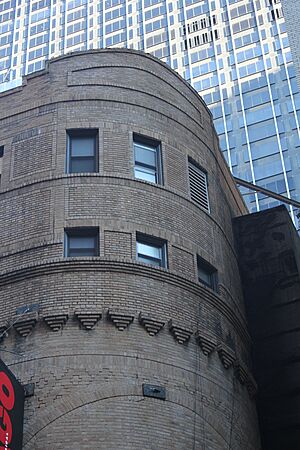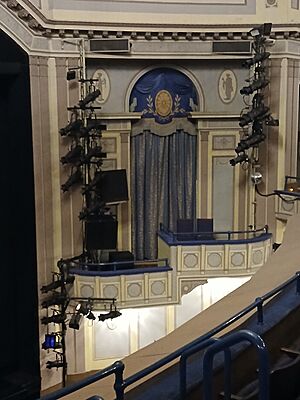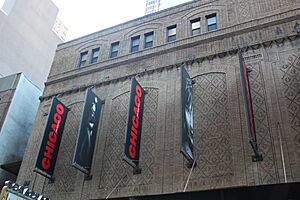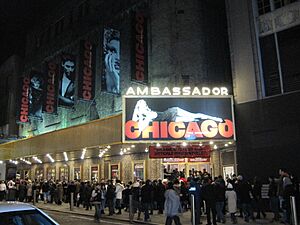Ambassador Theatre (Broadway) facts for kids
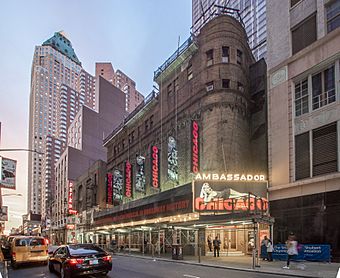 |
|
| Address | 219 West 49th Street Manhattan, New York United States |
|---|---|
| Coordinates | 40°45′40″N 73°59′06″W / 40.7612°N 73.9850°W |
| Public transit |
|
| Owner | The Shubert Organization |
| Type | Broadway |
| Capacity | 1,125 |
| Production | Chicago |
| Construction | |
| Opened | February 11, 1921 |
| Years active | 1921–1945, 1956–present |
| Architect | Herbert J. Krapp |
| Website | |
| shubert.nyc/theatres/ambassador/ | |
| Designated | August 6, 1985 |
| Reference no. | 1308 |
| Designated entity | Auditorium interior |
The Ambassador Theatre is a famous Broadway theater located at 219 West 49th Street in New York City. It's right in the heart of the Theater District in Midtown Manhattan. The theater first opened in 1921 and was designed by the architect Herbert J. Krapp for the famous theater owners, the Shubert brothers.
The Ambassador Theatre can hold 1,125 people in its audience. It is currently operated by The Shubert Organization, one of the biggest names in Broadway. Because of its historical and architectural importance, the inside of the theater is protected as a New York City designated landmark. This means it can't be changed without special permission.
For over twenty years, the Ambassador has been home to the hit musical Chicago.
Contents
Location and Design
The Ambassador Theatre sits on a square piece of land on 49th Street, between Eighth Avenue and Broadway. It is surrounded by other famous theaters and landmarks, making it a key part of New York's vibrant theater scene.
The theater was designed by Herbert J. Krapp, who had to be clever to fit as many seats as possible into a small space. To do this, he placed the entire theater on a diagonal angle. This unique layout allowed for 1,125 seats, whereas a normal layout would have only fit about 900.
The Outside of the Theater
The outside of the building, called the facade, is made of a golden-colored brick. The bricks are arranged in a special crisscross pattern. Compared to other theaters Krapp designed, the Ambassador has a simpler look.
The most noticeable feature is the curved entrance at the corner of the building, which faces toward Broadway. This corner entrance has glass and metal doors that lead into the lobby. Above the doors, a large sign, called a marquee, hangs over the sidewalk, showing the name of the current show.
Inside the Theater
The inside of the theater is called the auditorium. It has a main floor (the orchestra), a large balcony, and special seating areas called boxes on the sides. The auditorium was originally decorated in red and gold, with fancy details in what is known as the Adam style. This style includes elegant shapes, patterns, and carvings.
The stage is framed by a large, curved arch called a proscenium. Above the proscenium is a curved panel called a sounding board, which helps the actors' voices and music travel throughout the theater. The ceiling has a beautiful, shallow dome in the center with a large chandelier hanging from it.
The walls have decorative arches and panels, and the front of the balcony is lined with lights and more Adam-style designs. The whole design makes the audience feel like they are in a grand and special place.
History of the Theater
After World War I, the Shubert brothers wanted to build several new theaters near Times Square. The Ambassador was one of them, and it was built very quickly—in just 82 days!
Early Years and Different Uses
The Ambassador Theatre opened on February 11, 1921, with a musical called The Rose Girl. Its first big hit was an operetta (a type of light opera) called Blossom Time, which ran for over 500 performances. However, many of the shows in the 1920s and 1930s were not very successful.
In 1935, the Shuberts sold the theater. For the next 20 years, it was used for many different things. It became a radio studio for CBS, a movie theater that showed foreign films, and even a television studio for the DuMont Television Network.
Return to Live Theater
In 1956, the Shubert Organization bought the theater back and turned it into a live theater once again. Over the next few decades, it hosted many different plays and musicals. Some famous shows from this time include:
- The Diary of Anne Frank (1957)
- The Lion in Winter (1966)
- You Know I Can't Hear You When the Water's Running (1967)
- The musical Godspell (1976)
- A revival of the musical Dreamgirls (1987)
In 1985, the inside of the Ambassador Theatre was officially named a New York City landmark. This protected its beautiful, historic design for future generations to enjoy.
Home of Chicago
After a few other shows in the 1990s, including Bring in 'da Noise, Bring in 'da Funk, the Ambassador became home to a very special production.
In January 2003, the hit musical Chicago transferred to the Ambassador Theatre. The show had already been running for several years on Broadway, but it found a long-term home at the Ambassador. It has been playing there ever since. In 2014, Chicago became the second-longest-running show in Broadway history.
Like all Broadway theaters, the Ambassador had to close in March 2020 due to the COVID-19 pandemic. It reopened in September 2021 with performances of Chicago continuing for enthusiastic audiences. The show remains incredibly popular and has broken the theater's box-office records many times.
Famous Shows at the Ambassador
Here are some of the most well-known productions that have played at the Ambassador Theatre over the years.
- 1921: Blossom Time
- 1926: The Great Gatsby
- 1935: Night of January 16th
- 1957: The Diary of Anne Frank
- 1966: The Lion in Winter
- 1967: You Know I Can't Hear You When the Water's Running
- 1977: Godspell
- 1978: Eubie!
- 1987: Dreamgirls
- 1996: Bring in 'da Noise, Bring in 'da Funk
- 1999: You're a Good Man, Charlie Brown
- 2002: Topdog/Underdog
- 2003–present: Chicago
Images for kids
See also
 In Spanish: Teatro Ambassador (Nueva York) para niños
In Spanish: Teatro Ambassador (Nueva York) para niños
- List of Broadway theatres
- List of New York City Designated Landmarks in Manhattan from 14th to 59th Streets


